Chapter 8
Exploring the Power of Recommendations
In This Chapter
![]() Understanding recommendations
Understanding recommendations
![]() Writing a good recommendation
Writing a good recommendation
![]() Requesting a recommendation
Requesting a recommendation
![]() Declining a recommendation or a request for one
Declining a recommendation or a request for one
![]() Managing your recommendations
Managing your recommendations
Endorsements and testimonials have long been a mainstay of traditional marketing. But really, how much value is there in reading testimonials on someone's own Web site, like the following:
Maria is a great divorce attorney — I'd definitely use her again.
Elizabeth T. London
or
Jack is a fine lobbyist — a man of impeccable character.
Emanuel R. Seattle
Without knowing who these people are, anyone reading the testimonials tends to be highly skeptical about them. At the very least, the reader wants to know that they're real people who have some degree of accountability for those endorsements.
The reader is looking for something called social validation. Basically, that's just a fancy-shmancy term meaning that a person feels better about his decision to conduct business with someone if other people in his extended network are pleased with that person's work. The reader knows that people are putting their own reputations at stake, even if just to a small degree, by making a public recommendation of another person.
As this chapter shows you, the LinkedIn Recommendations feature offers you a powerful tool for finding out more about the people you're considering doing business with, as well as a means to build your own reputation in a way that's publicly visible. I walk you through all the steps needed to create a recommendation for someone else, request a recommendation for your profile, and manage your existing recommendations.
Understanding Recommendations
The LinkedIn Recommendation process starts in one of three ways:
- Unsolicited: When viewing the profile of any of your first-degree connections, a Recommend link is displayed when you click the drop-down arrow next to the Send a Message button in the middle of that person's profile, as shown in Figure 8-1. (For more information on connections, see Chapter 5.) By clicking that link, you can give an unsolicited recommendation.
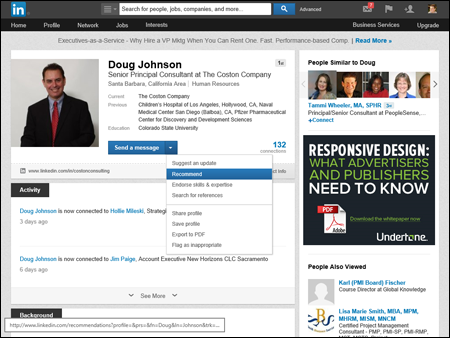
Figure 8-1: You can start a recommendation with any first-degree connection.
- Requested: You can request recommendations from your first-degree connections. You might send such a request at the end of a successful project, for example, or maybe ask for a recommendation from your boss before your transition to a new job.
- Reciprocated: Whenever you accept a recommendation from someone, LinkedIn gives you the option of recommending that person in return. Some people do this as a thank you for receiving the recommendation, other people reciprocate only because they didn't realize they could leave a recommendation until someone left them one, and some people don't feel comfortable reciprocating unless they truly believe the person deserves one. You decide in each circumstance whether to reciprocate, because there are circumstances where that might be awkward, such as if you get a recommendation from a supervisor or boss.
LinkedIn shows all recommendations you've received as well as links to the profiles of the people who recommended you. (See Figure 8-2.) This provides that social validation you want by allowing people to see exactly who is endorsing you.
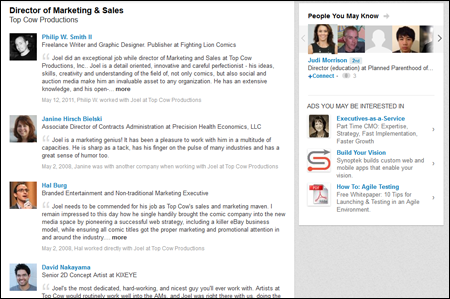
Figure 8-2: Recommendations shown on a profile page.
Writing Recommendations
I suggest you practice making some recommendations before you start requesting them. Here's the method to my madness: When you know how to write a good recommendation yourself, you're in a better position to help others write good recommendations for you. And the easiest way to get recommendations is to give them. Every time you make a recommendation and the recipient accepts it, she is prompted to give you a recommendation. Thanks to the basic desire that most people want to be fair when dealing with their network, many people will go ahead and endorse you in return.
Choose wisely, grasshopper: Deciding who to recommend
Go through your contacts and make a list of the people you want to recommend. As you build your list, consider recommending the following types of contacts:
- People you've worked with: I'm not going to say that personal references are completely worthless, but standing next to specific recommendations from colleagues and clients, they tend to ring pretty hollow. Business recommendations are much stronger in the LinkedIn context. Your recommendation is rooted in actual side-by-side experience with the other party, you can be specific on the behavior and accomplishments of the other party, and the examples you give are most likely to be appreciated by the professional LinkedIn community at large.
- People you know well: You may choose to connect with casual acquaintances or even strangers, but reserve your personal recommendations for people you have an established relationship with (and by that, I mean friends and family). Remember, you're putting your own reputation on the line with that recommendation. Are you comfortable risking your rep on them?
When you complete your To Be Recommended list, you're probably not going to do them all at once, so I suggest copying and pasting the names into a word processing document or spreadsheet so that you can keep track as you complete them.
Look right here: Making your recommendation stand out
Here are a few things to keep in mind when trying to make your recommendation stand out from the rest of the crowd:
- Be specific. Don't just say the person you're recommending is great: Talk about her specific strengths and skills. If you need help, ask the person you're recommending if there's any helpful elements they think you could highlight in your recommendation.
- Talk about results. Adjectives and descriptions are fluff. Clichés are also pretty useless. Tell what the person actually did and the effect it had on you and your business. It's one thing to say, “She has a great eye,” and another to say, “The logo she designed for us has been instrumental in building our brand and received numerous positive comments from customers.” Detailed results make a great impression, from the scope of difficulty of a project to the degree of challenge the person faced.
- Tell how you know the person. LinkedIn offers only the very basic categories of colleague, service provider, business partner, and student. If you've known this person for 10 years, say so. If she's your cousin, say so. If you've never met her in person, say so. Save it for the end, though. Open with the positive results this person provided, or the positive qualities the person exhibited in your interaction; then qualify the type of interaction.
- Reinforce the requestor's major skills or goals. Look at her profile. How is she trying to position herself now? What can you say in your recommendation that will support that? That will be far more appreciated by the recipient. For example, if you read her profile and see that she's really focusing on her project management skills as opposed to her earlier software development skills, your recommendation should reinforce that message because that's what she's trying to convey on her profile.
- Don't gush. By all means, if you think someone is fantastic, exceptional, extraordinary, or the best at what she does, say so. Just don't go on and on about it, and watch the overly clichéd adjectives.
- Be concise. Although LinkedIn has a 3,000-character limit on the length of recommendations, you shouldn't reach that limit. That should be more than enough to get your point across. Make it as long as it needs to be to say what you have to say, and no longer.
Creating a recommendation
Now you're ready to write your first recommendation. To create a recommendation, first you need to pull up the person's profile:
- Hover your mouse over the Network link from the top navigation bar of any page and then click the Contacts link from the drop-down list that appears.
- Select the person you're recommending from the connections list that appears.
 Your recommendation goes directly to that person, not prospective employers. Any prospective employer who wants a specific reference can request it through doing a reference search on LinkedIn, which I cover in greater detail in Chapter 11.
Your recommendation goes directly to that person, not prospective employers. Any prospective employer who wants a specific reference can request it through doing a reference search on LinkedIn, which I cover in greater detail in Chapter 11. - Visit the profile of the person you want to recommend.
Before you write up your recommendation, review the person's experience, summary, professional headline, and other elements of his profile. This helps you get a sense of what skills, attributes, or results should be reflected in your recommendation of that person. After all, if the person you want to recommend is trying to build a career as a finance executive, your recommendation will serve him better if you focus on finance instead of his event planning or writing skills, for example.
After you inform yourself a bit more about the person you're going to recommend and have thought about what you are going to say, you can get your recommending groove on. Follow these steps:
- Click the drop-down arrow next to the Send a Message button in the middle of his profile page, and then click the Recommend link from the drop-down list that appears.
- Select a category for that person.
As soon as you click the Recommend link, you're prompted to choose an option describing how you know this person, as shown in Figure 8-3.
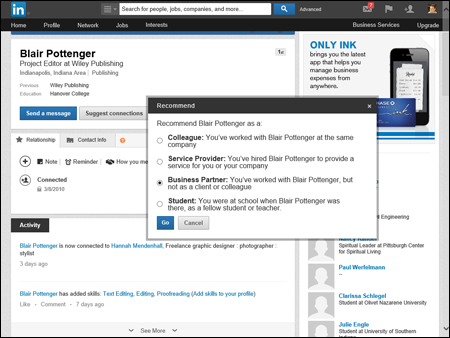
Figure 8-3: Tell LinkedIn how you worked with the person you are recommending.
Your four choices are
- Colleague: You worked together at the same company. This also includes situations where you or the other person was the boss.
- Service Provider: You hired the person to provide a service to you or your company.
- Business Partner: You worked with the person but not as a client or colleague. (Of course, common usage of “business partner” traditionally means that you're partners in a business together, but that isn't what this means. If you work in the same company as the other party, choose Colleague, even if you're both owners and not manager or employee.)
- Student: You went to school with the person, either as a fellow student or as a teacher.
As of this writing, there is no option for a personal relationship nor for you being a service provider to the person. In these cases, I recommend that you select Business Partner.
- Click the Go button.
The Create Your Recommendation page appears, as shown in Figure 8-4.
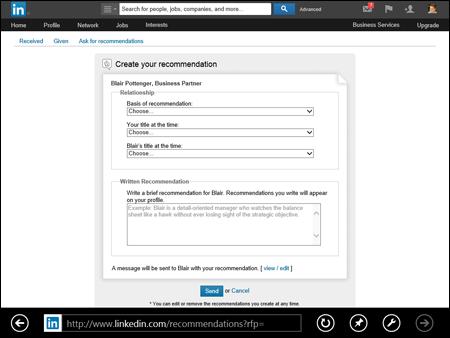
Figure 8-4: Create your recommendation here.
- Define your relationship with the person you're recommending by answering a few questions.
Each of the three drop-down boxes asks you to pick an answer from a predefined list. Specifically, you will be asked to
- Define the basis of the recommendation.
If you're a colleague of the person, LinkedIn wants to know whether you managed or worked side by side with the other party, or whether that person was the manager or senior official. If you're a business partner, LinkedIn wants to know whether you worked at a different company from the other person or whether the person was a client of yours.
- Define your title at the time.
Identify which position you held when you worked with or knew the other person you're recommending. This list is generated from the positions you defined in your LinkedIn profile. If your experience overlaps multiple positions, pick the position that best defines your relationship with the other party.
- Define the other person's title at the time.
You have to select at least one position that the other party held to associate the recommendation. You can enter only one recommendation per position, but you can recommend the other party on multiple positions.
By answering these questions, you inform anyone reading the recommendation about how you know the person you're recommending. Perhaps you were the person's manager at one time.
- Define the basis of the recommendation.
- Write the recommendation in the Written Recommendation field.
In earlier chapters, I stress staying specific, concise, and professional while focusing on results and skills. Keep in mind that recommendations you write that end up getting accepted by the other party also appear in your own profile in a tab marked Recommendations. Believe it or not, people judge you by the comments you leave about others, not just what they say about you. So, read your recommendation before you post it and look for spelling or grammatical errors. (You may want to prepare your recommendation in a word processing program like Microsoft Word, use its Spelling & Grammar check, and then cut and paste your newly pristine prose into the Written Recommendation field.)
- (Optional ) Include a note in the Personalize This Message text box.
When you send your recommendation, you have the option to also attach a personal note. Simply click the View/Edit link next to the line A message will be sent to Name with your recommendation. If it's someone you're in recent contact with, the note is probably unnecessary — the endorsement should speak for itself. But if it's someone you haven't spoken to in a while, take advantage of the opportunity to reconnect with a brief note. (See Figure 8-5.) You can keep the boilerplate text, “I've written this recommendation of your work to share with other LinkedIn users,” or you can write your own note, like I did in Figure 8-5. Let the person know why you are writing the recommendation, whether it's because you admire her work, enjoyed working with her, or wanted to recognize her for a job well done.
- Click Send.
The recommendation is sent to the recipient.
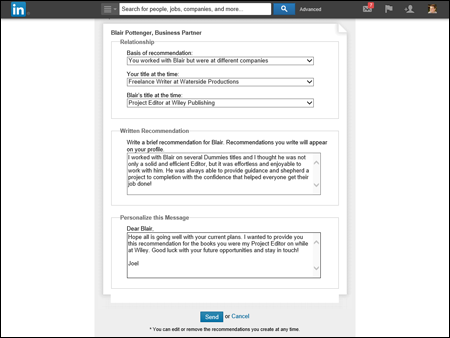
Figure 8-5: Sending a personal note with a recommendation is a good idea.
Requesting Recommendations
In an ideal world, you'd never request a recommendation. Everyone who's had a positive experience working with you would just automatically post a raving recommendation on LinkedIn. But the reality is that most likely only your raving fans and very heavy LinkedIn users are going to make unsolicited recommendations. Your mildly happy customers, former bosses whose jokes you laughed at consistently, and co-workers who you haven't seen in five years could all stand a little prompting.
Be prepared, though: Some people feel that recommendations should only be given freely, and they may be taken aback by receiving a recommendation request. So it's imperative that you frame your request with a personal message, not just a generic message from LinkedIn.
Choosing who to request recommendations from
Request recommendations from the same people you might write them for: colleagues, business partners, and service providers. The only difference is that you're looking at it from his point of view.
Relationships aren't all symmetrical. For example, if someone hears me speak at a conference and buys this book, that person is my customer. My customers know my skills and expertise fairly well — perhaps not on the same level as a consulting client, but still well enough to make a recommendation. I, on the other hand, might not know a customer at all. I'm open to getting to know him, and I'm willing to connect, but I can't write a recommendation for him yet.
Creating a polite recommendation request
When you identify the person (or people) you want to write your recommendations, you're ready to create a recommendation request. To get started on authoring your request, follow these steps:
- Click the Profile link from the top navigation bar to bring up your profile. Click the drop-down arrow next to the Edit button (in your Summary box) and click the Ask to Be Recommended link.
- After the Ask for Recommendations page loads, click the drop-down arrow (right there at Step 1 — see Figure 8-6) to choose what you want to be recommended for from the list provided.
LinkedIn ties this recommendation to a particular position or school attended from your profile, so you need to select the position (or school you were attending) where the recommender observed you and is providing his recommendation.
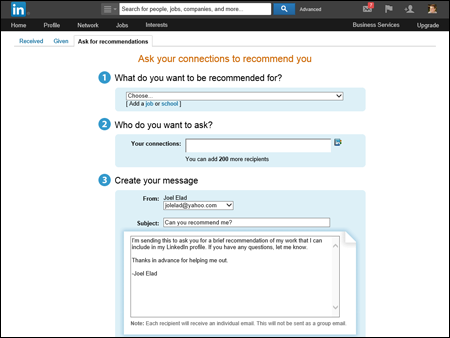
Figure 8-6: Select the position to be associated with your requested recommendation.
- Under the Who do you want to ask? header, type the name of the person you want to request a recommendation from into the Your Connections text field.
You can add the names of up to 200 people in this text field, and all will get a recommendation request.
 If you click the little blue In icon to the right of the text box, LinkedIn opens up a new window containing the list of your connections, which you can select by selecting the check box next to someone's name in the window.
If you click the little blue In icon to the right of the text box, LinkedIn opens up a new window containing the list of your connections, which you can select by selecting the check box next to someone's name in the window.As you start typing the name of the person, you should see that name pop up, as shown in Figure 8-7. Clicking the name adds it to the list of names visible in the Your Connections field. You can now type in another name if you would like to send this recommendation request to more than one person.
- Type your message in the field provided, as shown in Figure 8-8.
The same etiquette is recommended here as in other requests: Don't just accept the boilerplate text that LinkedIn fills in, but rather customize it to create a personal note, like I did in Figure 8-8. You can customize not only the body of your message, but the subject line as well.
 Don't forget to thank the person for the time and the effort in leaving you a recommendation!
Don't forget to thank the person for the time and the effort in leaving you a recommendation!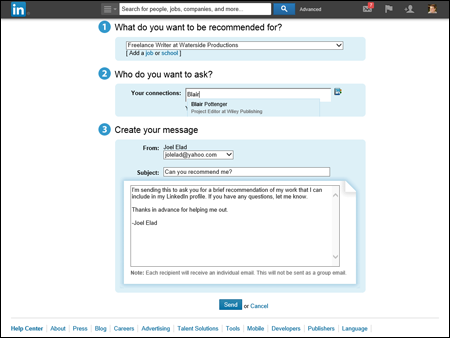
Figure 8-7: Confirm the person (or people) to request recommendations from.
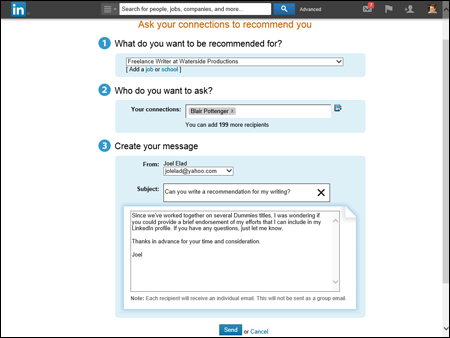
Figure 8-8: A customized recommendation request.
- Check your spelling and grammar.
You can write your message first using a program like Microsoft Word, run the Spelling & Grammar check, then cut and paste your message into the space provided, if you like.
- Click Send.
The recommendation request is sent to the intended recipient.
Gracefully Declining a Recommendation (Or a Request for One)
Unfortunately, not everyone naturally writes good recommendations, and all your LinkedIn connections haven't read this book, so it's bound to happen eventually: Someone will write a recommendation that you don't want to show on your profile.
No problem. Just politely request a replacement when you receive it. Thank him for thinking of you, and give him the context of what you're trying to accomplish:
- Wei:
- Thank you so much for your gracious recommendation. I'd like to ask a small favor, though. I'm really trying to position myself more as a public speaker in the widget industry, rather than as a gadget trainer. Since you've heard me speak on the topic, if you could gear your recommendation more toward that, I'd greatly appreciate it.
- Thanks,
- Alexa
If he's sincerely trying to be of service to you, he should have no problem changing it. Just make sure you ask him for something based on your actual experience with him.
Perhaps you don't have sufficient experience with her services to provide her a recommendation. If that's the case, just reply to her request with an explanation:
- Alexa:
- I received your request for a recommendation. While I'm happy to be connected to you on LinkedIn, and look forward to getting to know you better, or even work together in the future, at this point in time I just don't feel like I have enough basis to give you a really substantive recommendation.
- Once we've actually worked together on something successfully, I'll be more than happy to provide a recommendation.
- Thanks,
- Wei
Managing Recommendations
Relationships change over time. Sometimes they get better, occasionally they get worse, and sometimes they just change. As you get more recommendations, you might decide that you don't want to display them all, or that you would like some of them updated to support your current branding or initiatives.
Fortunately, neither the recommendation you give nor those you receive are etched in stone (or computer chips, as the case may be). You can edit or remove the recommendations you've written at any time, and you can hide or request revisions to those you receive.
Editing or removing recommendations you've made
To edit or remove a recommendation you've made, follow these steps:
- Hover your mouse over the Profile link from the top navigation bar and then choose Edit Profile from the Profile drop-down list that appears.
- Scroll down to the Recommendations section and click the Edit ( pencil icon) link.
Doing so brings up the Your Recommendations header along the right side of the page.
- Click the Manage Visibility link to bring up the Recommendations page. Then click the page's Given tab.
All the recommendations you've made are listed in reverse chronological order, as shown in Figure 8-9. You can narrow the list down by clicking the link for Colleagues, Service Providers, Business Partners, or Students below the Manage Recommendations You've Sent header.
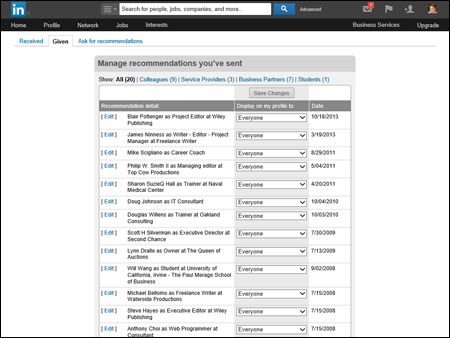
Figure 8-9: Pick the recommendation you want to edit or delete.
- Click the Edit link next to the recommendation you want to change or remove.
You're taken to the Edit Your Recommendation screen, as shown in Figure 8-10.
- Edit: You can update some of the Relationship choices, such as Basis of Recommendation, or update your Written Recommendation text. When you're done, click Send at the bottom of the screen.
- Remove: Simply click the Withdraw This Recommendation link to ditch the recommendation completely. This link can be found at the top of the page, between the person's name and the Relationship header.
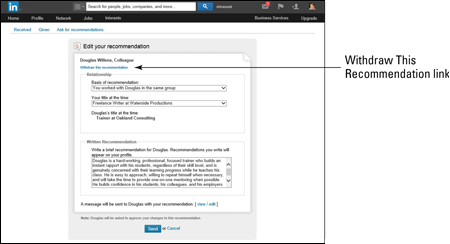
Figure 8-10: Make changes to your recommendation or withdraw it altogether.
An edited recommendation is submitted to the recipient again for approval. If you remove it, it comes off immediately, and the recipient (or is that the unrecipient?) doesn't receive any notification.
Handling new recommendations you've received
Every time you receive a recommendation from someone else, you see a message in your LinkedIn Inbox, as shown in Figure 8-11.
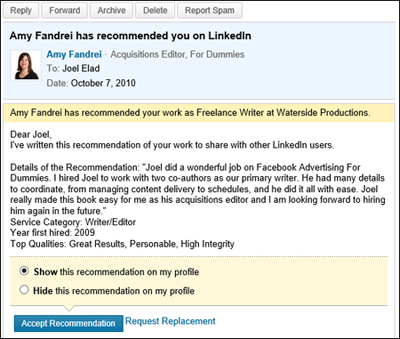
Figure 8-11: Here is where you can accept an incoming recommendation.
When you receive a recommendation, you have these options:
- Accept and show it on your profile. Click the Accept Recommendation button but also make sure the Show This Recommendation on My Profile option is selected.
- Accept and hide it. You might choose this option if you don't want to decline the person's recommendation, but for some reason you don't want to display it (see the following section). Here, just make sure the Hide This Recommendation option is selected before you click the Accept Recommendation button.
- Request replacement. If you aren't completely happy with the person's recommendation, click the Request Replacement link to be given the opportunity to send him a brief note explaining what you would like changed.
- Archive it. This removes the recommendation message from your LinkedIn Inbox. It is available for later retrieval, just not as easily as if you choose the Hide option. You simply have to click the Show Archived Messages link when looking at your LinkedIn Inbox for recommendations; I cover the Inbox in detail in Chapter 10.
Removing a recommendation or requesting a revision
To remove a recommendation you've received or to request a revision, here's what you do:
- Hover your mouse over the Profile link from the top navigation bar and then choose Edit Profile from the menu that appears.
- Scroll down to the Recommendations section and click the Edit link. When the Your Recommendations header appears on the right side of the screen, click the Manage Visibility link underneath that header.
Doing so takes you to the Manage Recommendations You've Received page, as shown in Figure 8-12.
- Pick the position from your Experience list that the recommendation is tied to, and click the Manage link below that title to bring up all the recommendations for that position, as shown in Figure 8-13.
- To remove a recommendation, deselect the Show check box. Then scroll down and click the Save Changes button to hide your recommendation.
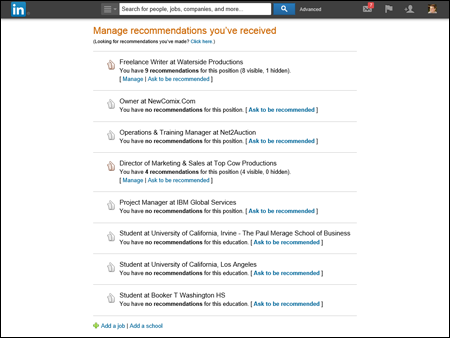
Figure 8-12: Manage your recommendations by selecting your position first from the list.

Figure 8-13: Remove a recommendation or request a revision here.
- To request a new or revised recommendation, click the Request a New or Revised Recommendation From Name link.
This takes you back to the Request Recommendation screen (which I cover in the earlier section, “Creating a polite recommendation request”), where you should write a brief note explaining why you're requesting a change.
- Click Send.
Negotiating the social graces around recommendations might feel a little awkward at first, but with some practice, you'll quickly become comfortable. By both giving and receiving good recommendations, you'll build your public reputation, increase your social capital with your connections, and have a good excuse for renewing some of your relationships with people you haven't contacted recently.

 Recommend only those people whose performance you're actually happy with. I can't say it enough: Your reputation is on the line. Recommending a real doofus just to get one recommendation in return isn't worth it! Here's a great question to ask yourself when deciding whether to recommend someone: Would you feel comfortable recommending this person to a best friend or family member? If not, well, then, you have your answer.
Recommend only those people whose performance you're actually happy with. I can't say it enough: Your reputation is on the line. Recommending a real doofus just to get one recommendation in return isn't worth it! Here's a great question to ask yourself when deciding whether to recommend someone: Would you feel comfortable recommending this person to a best friend or family member? If not, well, then, you have your answer.